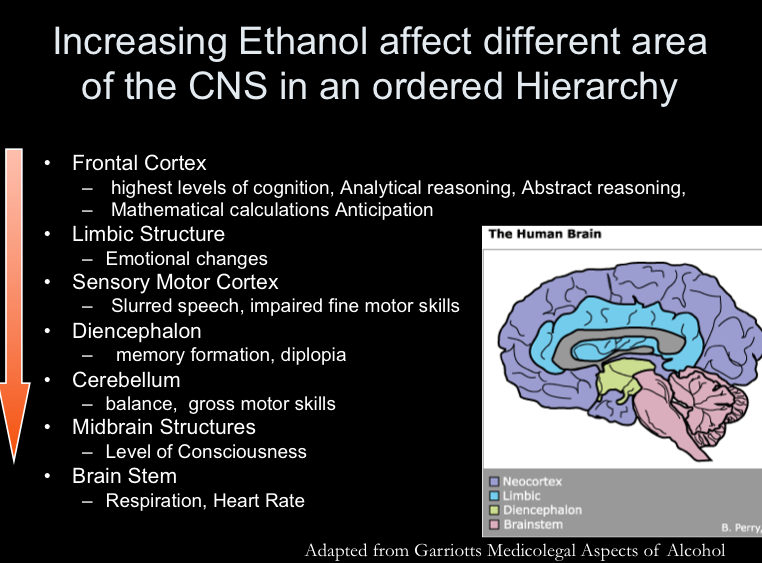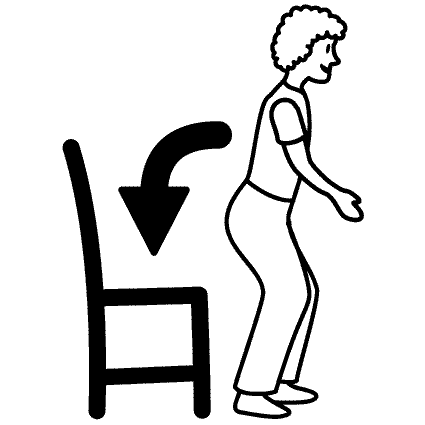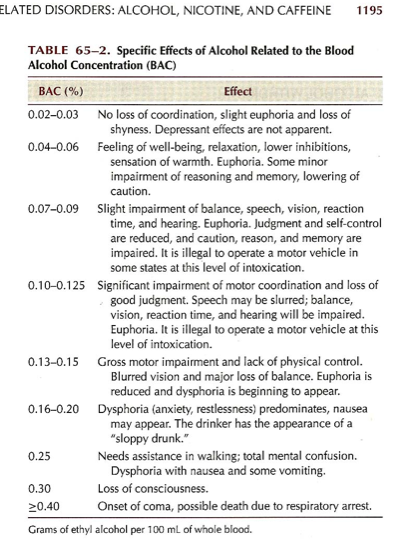It seems every day, there is some sort of news report that claims that there is a new “record breaking” Blood Alcohol Content (BAC) or Breath Alcohol Content (BrAC) result in a DUI case. Is this so?
Ethanol is perhaps the most studied drug in the history of mankind. As such, and due to the pharmacokinetics of it being a zero order kinetic (really Michaelis–Menten kinetic), we know a whole lot about this drug.
First, there is a very well established hierarchy of effect on our central nervous system based upon dosage. It is best encapsulated in this chart:

As true arterial BAC increases so does the magnitude of effect as shown above (the pharmacodynamic impact). The trick to it is that this is a progressive, incremental and mandatory step-wise hierarchy. You cannot skip steps in this rigid order of pharmacodynamic effect. If the perceived observed dysfunction is truly and uniquely due to ethanol all of the preceding steps must be present.
For example, if the motorist can perform high abstract executive order thinking (such as weighing the consequences appropriately of refusing to give a BAC or BrAC sample after being instructed in complex legalese that is the Implied Consent Demand) but has noted gross motor dysfunction such as not being able to do the Walk and Turn to the officer’s satisfaction, then this perceived gross motor dysfunction is out of order in the noted hierarchy of pharmacodynamic effect of EtOH as the high abstract executive order thinking remains intact. As a result, the most medically and pharmacodynamically legitimate explanation is that the perceived and observed gross motor dysfunction must be attributed to something else such as nerves or it being an impossible task for him/her to ever preform (even on his or her most gymnastic day) rather than impairment due to EtOH consumption.
There is a ready apparent and demonstrable disconnect between the analytical chemistry result (the BAC or BrAC) and well-studied and predictable hierarchy of pharmacodynamic effect.
Perhaps the best measure of this disconnect occurs in the act of standing up or sitting down.

The physical act of simply standing up or siting down is a horribly complicated function to do if there is true impairment. Standing up from a seated position without difficulty requires great proprioception, fine and gross motor function, situational awareness, equilibrioception (balance), and coordination. Proprioception is so very important in these cases. Proprioception comes from Latin proprius, meaning “one’s own,” and perception — is one of the human senses. Rather than sensing external reality, proprioception is the sense of the orientation of one’s limbs in space. This is distinct from the sense of balance, which derives from the fluids in the inner ear. Without proprioception, we would need to consciously watch our feet to make sure that we stay upright while walking. Proprioception does not come from any specific organ, but from the nervous system as a whole. Its input comes from sensory receptors distinct from tactile receptors — nerves from inside the body rather than on the surface. Without proprioception, drivers would be unable to keep their eyes on the road while driving, as they would need to pay attention to the position of their arms and legs while working the pedals and steering wheel. And I would not be able to type this without staring at the keys. If you happen to be snacking while reading this article, you would be unable to put food into your mouth without taking breaks to judge the position and orientation of your hands versus your mouth. In a given DUI case there are many times where this seemly simple, but totally crucial task of standing or sitting is completed: officer orders/requests driver to get out of the car to do SFSTs; the motorist is arrested and has to sit in the squad car; motorist has to get out of squad car; motorist has to sit in BrAC or blood draw chair; motorist has to stand up when done from BrAC or blood draw; and in given cases there may be more such as fingerprinting and processing, waiting in the drunk tank sitting up or down; sitting in a chair waiting for a ride; and so on. You can have upwards of 8-10 times where this all important task is tested that is so very integral to driving safely. Now with these disconnect cases, if the motorist can do this seemly simple but truly difficult task repeatedly without fail but stumbles only once or sways for a limited period of time, then much like the previous example we have great proof of non-impairment. Again, as it is out of order of the hierarchy of effect, then the most medically and pharmacodynamically legitimate explanation is that the perceived and alleged dysfunction must be attributed to something else such as nerves or it being an aberrant act (an outlier).
Then we have the dosage versus expected response as encapsulated by the chart below:

Again in this chart, we note how this is a progressive well-known hierarchy. Again, remembering how it has to go in order, if there are things out of order, then they must be ignored as being aberrant or some other cause having noting to do with ethanol.
Then there is the clincher. The pharmacokinetics of it. In a typical DUI case, the government likes to use retrograde to get the motorist’s BAC or BrAC up. Well, in a classic disconnect that’s where these “record breaking” BAC or BrAC reports are put to the test. Chemical tests of breath or blood are seldom taken at roadside contemporaneous with driving, but at some time later. According to the government, the delay from the driving to collection of the chemical sample will most likely mean the person was post-absorptive (really post peak). The result of the retrograde extrapolation use to arrive at a time of driving projected BAC result makes this whole report of the “record breaking” BAC or BrAC even more ridiculous.
The ability to find one’s keys, put the relatively small sized key into the small hole to turn the classic ignition, to get it in gear and not hit a ton of shit along the way, as well as stop the car, put it in park and shut it down when the traffic stop happens is just not realistically possible at that high a result. At that high a result, the person should be literally dying.
It all comes down to the old medical adage: “If a pregnancy test came back positive for a man. That don’t make it so.” You treat the patient not the number. At that high a level based upon their training, the police should have immediately taken him to the hospital for advanced medical treatment. It is part of all police training nationwide for liability purposes. When this is not done, the BrAC operator likely did the right thing. He or she disregarded his/her protocol because good old fashioned common sense. The police officer didn’t believe the result, nor should you ladies and gentlemen of the jury.
In this case, there is but one result that makes sense: Not guilty.The number is not valid. It is wrong.



Tad Hansch says:
I love it! TCS